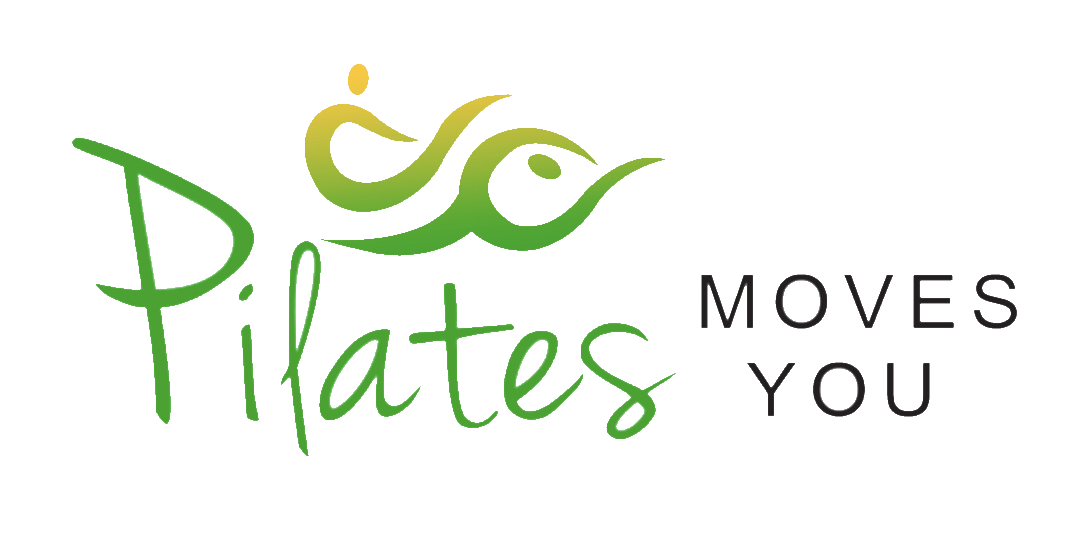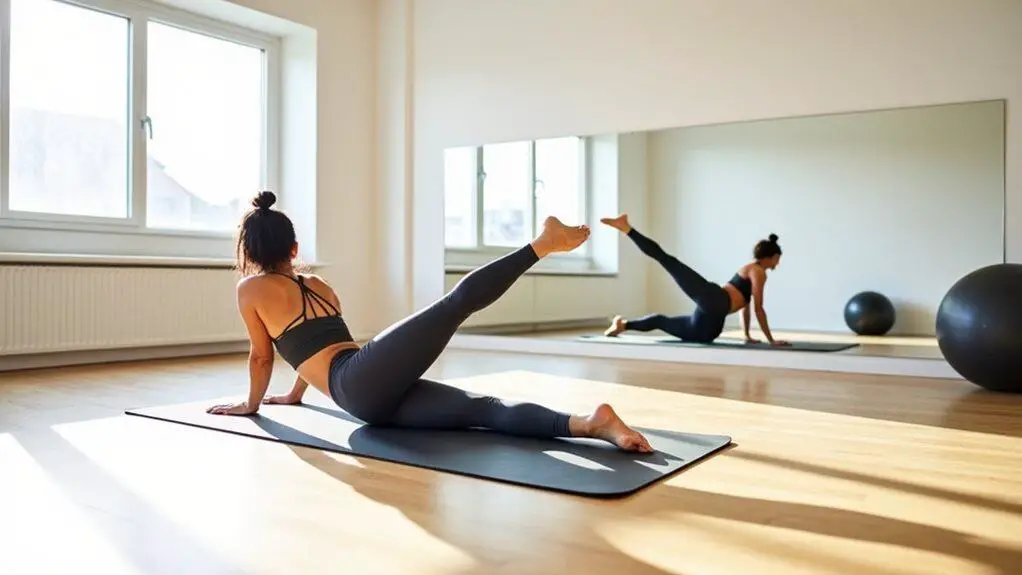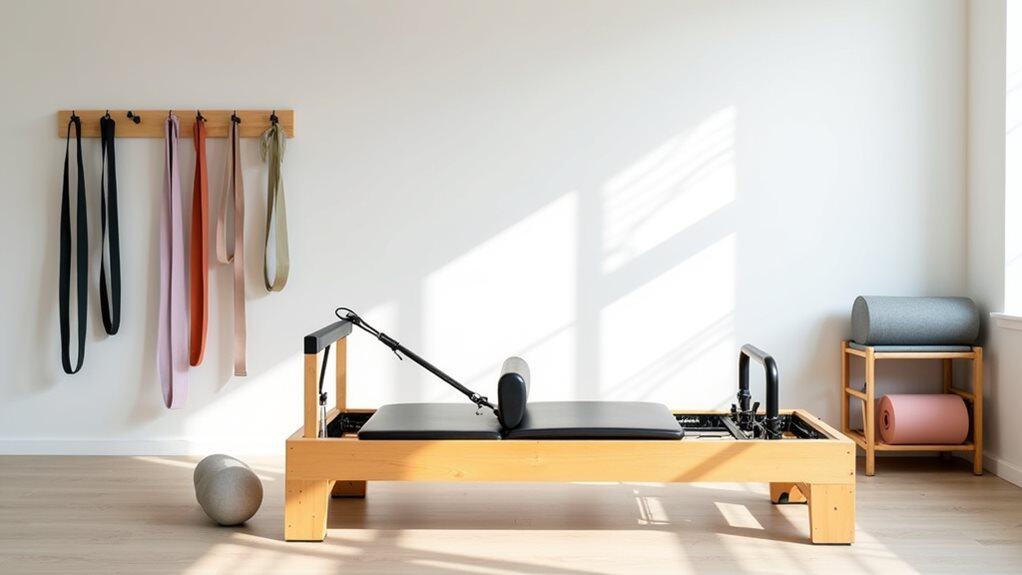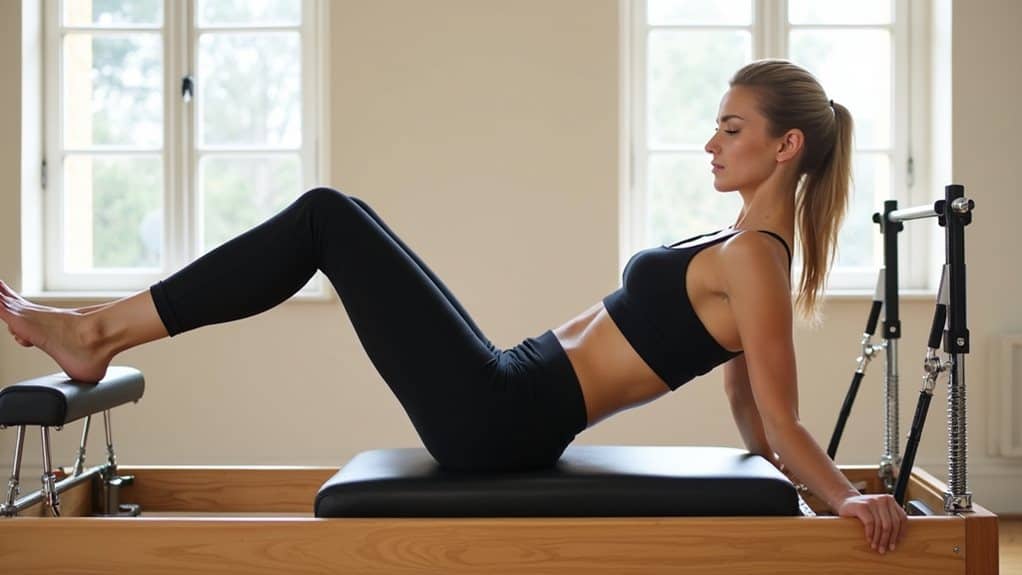Are you feeling stressed, overwhelmed, or just generally run down? We all experience these feelings from time to time, but it’s important to take steps to nurture our mental well-being.
One way to do this is through the practice of Pilates. Pilates is a low-impact form of exercise that focuses on building core strength, improving posture, and increasing flexibility. But it’s not just a physical workout – Pilates also has numerous benefits for mental health.
In this article, we’ll explore the mind-body connection and how Pilates can help reduce stress, anxiety, and depression. We’ll also provide tips for getting started with Pilates, basic and advanced techniques, and how to incorporate mindfulness and self-care into your practice.
So let’s dive in and discover the tranquil benefits of Pilates for mental well-being!
Key Takeaways
- Pilates can improve mental well-being by reducing stress, anxiety, and depression.
- Focusing on breath and body movements during Pilates can help quiet the mind and reduce stress.
- Consistent Pilates practice can boost self-esteem and confidence.
- Pilates encourages mindfulness and being fully present in the body.
Understanding the Mind-Body Connection
You’ll be amazed at how understanding the mind-body connection can transform your Pilates practice and enhance your mental well-being! Pilates isn’t just a physical exercise, but it also involves the mind.
The mind-body connection is the relationship between the physical body and the mind. It’s the idea that the mind and body are interconnected and that one affects the other.
Meditation practices and yoga therapy are two examples of mind-body practices that can help you understand the connection between your mind and body. These practices can help you become more aware of your thoughts, emotions, and physical sensations. By practicing mindfulness, you can learn to observe your thoughts and emotions without judgment, which can help you manage stress and anxiety.
Understanding the mind-body connection can help you get the most out of your Pilates practice. By focusing on your breath and being present in the moment, you can improve your concentration and focus. This can help you perform Pilates exercises with greater precision and control. Additionally, by being more aware of your body, you can prevent injuries and improve your overall physical health.
By understanding the mind-body connection, you can unlock the full potential of Pilates for mental well-being. In the next section, we’ll explore the benefits of Pilates for mental health and how it can help you achieve a sense of calm and tranquility.
The Benefits of Pilates for Mental Health
Feeling stressed or anxious? Pilates can provide a natural way to improve your mental health and find peace of mind.
Pilates is a form of exercise that focuses on controlled movements and breathing techniques to strengthen your core and improve your flexibility. But beyond the physical benefits, Pilates has been shown to have a positive impact on mental health by reducing stress and anxiety levels.
Pilates and stress relief go hand in hand. The flowing movements and focus on breathing can help you feel more relaxed and calm. Additionally, Pilates can be a form of meditation in motion, allowing you to clear your mind and focus on the present moment.
By incorporating Pilates into your routine, you may find that you are better equipped to handle the stresses of daily life.
Furthermore, Pilates can be a powerful tool for anxiety management. The mind-body connection inherent in Pilates can help you become more aware of your body and its sensations. This increased awareness can help you identify when you are feeling anxious and take steps to manage those feelings.
By practicing Pilates regularly, you may find that your anxiety levels decrease and that you are better equipped to cope with the challenges that life throws your way.
Ready to try Pilates for yourself? Check out the next section to learn more about getting started with this transformative exercise.
Getting Started with Pilates
To begin incorporating Pilates into your fitness routine, it’s important to find a qualified instructor who can guide you through the proper techniques and form. Many gyms offer Pilates classes, but it’s important to do your research and find a class that fits your schedule and budget. Alternatively, you can find private Pilates instructors who can provide one-on-one sessions tailored to your specific needs.
When starting out with Pilates, it’s important to wear comfortable clothing that allows for a full range of motion. You may also want to invest in Pilates equipment such as a mat, resistance bands, or Pilates balls to enhance your practice. Your instructor can guide you on what equipment is necessary and how to use it properly.
Overall, the key to success with Pilates is consistency and patience. It may take some time to get comfortable with the movements and build strength, but with regular practice, you’ll start to see improvements in your physical and mental well-being. In the next section, we’ll explore some basic Pilates techniques that you can incorporate into your practice to help you achieve your fitness goals.
Basic Pilates Techniques
Start mastering Pilates techniques by focusing on your core muscles and breathing patterns. The foundation of Pilates is built upon the principle of controlling movements through the core muscles. This is important because it helps to improve body alignment, posture, and balance. Proper body alignment is essential to executing Pilates exercises correctly. When you’re in the correct position, you’ll be able to target the intended muscles effectively.
To improve your Pilates practice, it’s important to master breathing techniques. Breathing in Pilates isn’t just about inhaling and exhaling; it’s about utilizing your breath to help control your movements. Proper breathing can help you engage your core muscles and improve your overall posture. In Pilates, breathing is done by inhaling through the nose and exhaling through the mouth. As you exhale, you should engage your core muscles, which will help you to create stability and control.
To engage the audience, here are two sub-lists that will help you get started with Pilates techniques:
- Body alignment:
- Stand with your feet hip-width apart.
- Engage your core muscles by pulling your belly button towards your spine.
- Relax your shoulders and keep them away from your ears.
- Keep your head in a neutral position, looking straight ahead.
- Distribute your weight evenly on both feet.
- Breathing techniques:
- Inhale through the nose and expand your ribcage.
- Exhale through the mouth and engage your core muscles.
- Focus on breathing deeply and evenly throughout the exercise.
As you become more comfortable with basic Pilates techniques, you can move on to more advanced exercises. In the next section, we’ll discuss advanced Pilates exercises that will challenge your body and mind. By incorporating these techniques into your daily routine, you can enhance your mental well-being and rejuvenate your spirit.
Advanced Pilates Exercises
Now that you’ve mastered the basics, it’s time to take your Pilates practice to the next level with challenging advanced exercises. These exercises focus on core strengthening and flexibility training, which builds on the foundation you’ve established with the basics.
Advanced Pilates exercises incorporate movements that require more control and balance, which can help you build more strength, improve your posture, and increase your overall body awareness. One of the most challenging advanced Pilates exercises is the Teaser. This exercise requires you to lie on your back with your arms and legs extended, and slowly lift your upper body off the mat until you reach a seated position.
This exercise targets the entire core, from the abs to the back muscles, and requires a great deal of control and balance. Another advanced exercise is the Scissor, which involves lifting both legs off the mat and alternating them in a scissors-like motion. This exercise targets the lower abs and hip flexors, and can help increase your flexibility and stability.
Incorporating advanced Pilates exercises into your routine can help you build more strength, improve your posture, and increase your overall body awareness. These exercises can be challenging, but with practice, they can help you achieve your fitness goals.
In the next section, we’ll explore how Pilates can be used as a tool for mindfulness and mental well-being. Let’s dive in!
Pilates and Mindfulness
Pilates can be a powerful tool for connecting the mind and body, allowing for greater awareness of movement patterns and physical sensations. Mindful Pilates, in particular, emphasizes the importance of being present and fully engaged in each movement, incorporating Pilates meditation techniques to enhance the mind-body connection. By practicing Pilates with a mindful approach, we can cultivate a sense of inner calm and focus that can carry over into other areas of our lives.
One way to incorporate mindfulness into Pilates is through the use of a Pilates meditation table. This table is a simple tool that can help us stay present and focused during our Pilates practice. The table has two columns and three rows, with each cell representing a different aspect of the Pilates practice. For example, one cell might be dedicated to breathing, while another might focus on alignment. By using the table to guide our practice, we can stay focused on the present moment and avoid getting distracted by outside thoughts or distractions.
Incorporating mindfulness into our Pilates practice can have a profound impact on our mental well-being. By cultivating a sense of inner calm and focus, we can reduce stress and anxiety, improve our mood, and enhance our overall sense of well-being. As we move into the next section on Pilates and self-care, we can explore how this mindful approach to Pilates can help us prioritize our mental and physical health and make space for the self-care we all need.
Pilates and Self-Care
Incorporating a regular Pilates practice into your self-care routine can provide numerous benefits for physical and emotional health. Pilates is a low-impact exercise that focuses on strengthening the core muscles, improving posture, and increasing flexibility. These physical benefits can lead to improved confidence and self-esteem, which can positively impact mental well-being.
Not only does Pilates provide physical benefits, but it can also be a form of mindfulness and stress relief. During a Pilates session, you’re encouraged to focus on your breath and body movements, which can help quiet the mind and reduce stress. By incorporating Pilates into your daily routine, you can prioritize self-care and take time to focus on your mental and physical health.
Making Pilates a part of your daily routine can be a powerful form of self-care. It can help you create a sense of balance and improve overall well-being. By prioritizing your health and making time for Pilates, you’re taking an important step towards a more fulfilling and healthy lifestyle.
In the following section, we’ll explore the long-term benefits of Pilates for mental well-being.
The Long-Term Benefits of Pilates for Mental Well-being
You can experience a multitude of positive effects on your emotional and mental health by consistently practicing Pilates. This practice isn’t just about physical fitness but also mindfulness practices and stress management techniques. Here are three ways Pilates can help your mental well-being:
- Reduce stress levels: Pilates involves slow, controlled movements that require focus and concentration. By focusing on your breath and movements, you can let go of stress and tension in your body. Additionally, the mind-body connection developed through Pilates can help you manage stress more effectively in your daily life.
- Improve mood: Pilates can release endorphins, the body’s feel-good hormones, which can improve your mood and reduce symptoms of anxiety and depression. Consistent practice can also boost self-esteem and confidence, leading to a more positive outlook on life.
- Increase mindfulness: Pilates encourages you to focus on the present moment and be fully present in your body. This mindfulness practice can help you let go of negative thoughts and emotions and cultivate a sense of calm and inner peace.
Incorporating Pilates into your routine can have long-term benefits for your mental well-being. By reducing stress levels, improving mood, and increasing mindfulness, Pilates can help you cultivate a sense of inner peace and improve your overall quality of life. So, why not give it a try and see how it can benefit you?
Conclusion
In conclusion, embracing the tranquil benefits of Pilates for mental well-being can be a life-changing decision. By understanding the mind-body connection, we can appreciate the power of Pilates in enhancing our mental health.
From reducing stress and anxiety to increasing focus and concentration, Pilates offers an array of benefits that can help us lead a more balanced and fulfilling life. If you’re new to Pilates, don’t be intimidated! With basic techniques like the Pilates breathing and the pelvic tilt, anyone can start experiencing the benefits of this practice.
As you progress, you can challenge yourself with advanced exercises that will strengthen your body and mind. Just remember to approach Pilates with mindfulness and self-care, and to make it a long-term commitment for optimal results.
With Pilates, you can nurture your mind and rejuvenate your spirit, and unlock your full potential for mental well-being.




